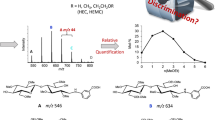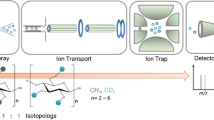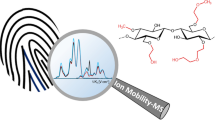Abstract
Three hydroxypropyl methylcellulose samples (HPMC1–3, DSMe = 1.45, 1.29, and 1.36; MSHP = 0.28, 0.46, and 0.84) were analyzed with respect to their methyl and hydroxypropyl substitution pattern in the polymer chains. Ionization yield of HPMC oligomers in electrospray ionization ion trap mass spectrometry (ESI-IT-MS) is strongly influenced by the hydroxypropyl pattern. Therefore, a sample derivatization procedure, as well as suitable measurement conditions that enable relative quantification were elaborated. Analysis was performed by negative ESI-IT-MS after per(deutero)methylation, partial depolymerization, and reductive amination with m-aminobenzoic acid. Measurement parameters like solvent, trap drive, and voltages of the ion transportation unit were studied with regard to the suitability for quantitative evaluation. Using direct infusion of the samples, strong influence of trap drive and octopole settings was observed. Optimized measurement conditions were used for the determination of the HP pattern of the permethylated samples by direct infusion. The methyl pattern was determined from the perdeuteromethylated samples by high-performance liquid chromatography–electrospray tandem mass spectrometry. For HPMC1, substituents were both found to fit the random distribution model. The other two samples showed pronounced heterogeneity which could be interpreted in more detail by extracting methyl subpatterns depending on the number of HP groups.

Determination of the substituent distribution in hydroxypropyl methylcellulose oligomers by ESI-IT-MS (negative mode) after labeling with m-aminobenzoic acid







Similar content being viewed by others
Abbreviations
- ACN:
-
Acetonitrile
- AGU:
-
Anhydroglucose unit
- DP:
-
Degree of polymerization
- DSMe :
-
Degree of methyl substitution
- EIC:
-
Extracted ion chromatogram
- ESI:
-
Electrospray ionization
- GLC:
-
Gas–liquid chromatography
- HP:
-
Hydroxypropyl
- HPLC:
-
High-performance liquid chromatography
- HPMC:
-
Hydroxypropyl methylcellulose
- IT:
-
Ion trap
- mABA:
-
m-aminobenzoic acid
- Me:
-
Methyl
- MS:
-
Mass spectrometry
- MSHP :
-
Molar degree of hydroxypropyl substitution
- r.t.:
-
Room temperature
References
Thielking H, Schmidt M (2006) Cellulose ethers. In: Ullmann's Encyclopedia of Industrial Chemistry. Wiley, New York
Siepmann J, Kranz H, Bodmeier R, Peppas NA (1999) HPMC-matrices for controlled drug delivery: a new model combining diffusion, swelling, and dissolution mechanisms and predicting the release kinetics. Pharm Res 16:1748–1756
Haque A, Richardson RK, Morris ER, Gidley MJ, Caswell DC (1993) Thermogelation of methylcellulose. Part II: effect of hydroxypropyl substituents. Carbohydr Polym 22:175–186
Burchard W (2003) Solubility and solution structure of cellulose derivatives. Cellulose 10:213–225
Mischnick P, Momcilovic D (2010) Chemical structure analysis of starch and cellulose derivatives. Adv Carbohydr Chem Biochem 64:117–210
Viridén A, Wittgren B, Andersson T, Abrahmsén-Alami S, Larsson A (2009) Influence of substitution pattern on solution behavior of hydroxypropyl methylcellulose. Biomacromolecules 10:522–529
Adden R, Müller R, Mischnick P (2006) Fractionation of methyl cellulose according to polarity—a tool to differentiate first and second order heterogeneity of the substituent distribution. Macromol Chem Phys 207:954–965
Cuers J, Unterieser I, Burchard W, Adden R, Rinken M, Mischnick P (2012) Simultaneous determination of substituent patterns in partially acid hydrolyzed O–Me/O–Me-d 3-cellulose and quantification of the obtained oligomers by HPLC-ESI-MS. Carbohydr Res 348:55–63
Mischnick P, Adden R (2008) Fractionation of polysaccharide derivatives and subsequent analysis to differentiate heterogeneities on various hierarchical levels. Macromol Symp 262:1–7
Arisz PW, Kauw HJJ, Boon JJ (1995) Substituent distribution along the cellulose backbone in O-methylcelluloses using GC and FAB-MS for monomer and oligomer analysis. Carbohydr Res 271:1–14
Mischnick P, Heinrich J, Gohdes M, Wilke O, Rogmann N (2000) Structure analysis of 1,4-glucan derivatives. Macromol Chem Phys 201:1985–1995
Heinrich J, Mischnick P (1996) Rapid method for the determination of the substitution pattern of O-methylated 1,4-glucans by high-pH anion-exchange chromatography with pulsed amperometric detection. J Chromatogr A 749:41–45
Voiges K, Adden R, Rinken M, Mischnick P (2012) Critical re-investigation of the alditol acetate method for analysis of substituent distribution in methyl cellulose. Cellulose 19:993–1004
Lazik W, Heinze T, Pfeiffer K, Albrecht G, Mischnick P (2002) Starch derivatives of a high degree of functionalization. VI. Multistep carboxymethylation. J Appl Polym Sci 86:743–752
Mischnick P (2012) Mass spectrometric characterization of oligo- and polysaccharides and their derivatives. Adv Polym Sci 248:105–174
Lamari FN, Kuhn R, Karamanos NK (2003) Derivatization of carbohydrates for chromatographic, electrophoretic and mass spectrometric structure analysis. J Chromatogr B 793:15–36
Adden R, Müller R, Mischnick P (2006) Analysis of the substituent distribution in the glucosyl units and along the polymer chain of hydroxypropylmethyl celluloses and statistical evaluation. Cellulose 13:459–476
Unterieser I, Cuers J, Voiges K, Enebro J, Mischnick P (2011) Quantitative aspects in electrospray ionization ion trap and matrix-assisted laser desorption/ionization time-of-flight mass spectrometry of malto-oligosaccharides. Rapid Commun Mass Spectrom 25:2201–2208
Unterieser I, Mischnick P (2011) Labeling of oligosaccharides for quantitative mass spectrometry. Carbohydr Res 346:68–75
Schmidt A, Karas M, Dülcks T (2003) Effect of different solution flow rates on analyte ion signals in nano-ESI MS, or: when does ESI turn into nano-ESI? J Am Soc Mass Spectrom 14:492–500
Tang L, Kebarle P (1993) Dependence of ion intensity in electrospray mass spectrometry on the concentration of the analytes in the electrosprayed solution. Anal Chem 65:3654–3667
Schriemer DC, Li L (1997) Mass discrimination in the analysis of polydisperse polymers by MALDI time-of-flight mass spectrometry. 2. Instrumental issues. Anal Chem 69:4176–4183
Kebarle P, Verkerk UH (2009) Electrospray: from ions in solution to ions in the gas phase, what we know now. Mass Spectrom Rev 28:898–917
Kruve A, Herodes K, Leito I (2010) Optimization of electrospray interface and quadrupole ion trap mass spectrometer parameters in pesticide liquid chromatography/electrospray ionization mass spectrometry analysis. Rapid Commun Mass Spectrom 24:919–926
Titato GM, Bicudo RC, Lanças FM (2007) Optimization of the ESI and APCI experimental variables for the LC/MS determination of s-triazines, methylcarbamates, organophosphorous, benzimidazoles, carboxamide and phenylurea compounds in orange samples. J Mass Spectrom 42:1348–1357
Murgasova R, Hercules D (2002) Polymer characterization by combining liquid chromatography with MALDI and ESI mass spectrometry. Anal Bioanal Chem 373:481–489
Gruendling T, Guilhaus M, Barner-Kowollik C (2008) Quantitative LC-MS of polymers: determining accurate molecular weight distributions by combined size exclusion chromatography and electrospray mass spectrometry with maximum entropy data processing. Anal Chem 80:6915–6927
Byrd HCM, McEwen CN (2000) The limitations of MALDI-TOF mass spectrometry in the analysis of wide polydisperse polymers. Anal Chem 72:4568–4576
Mischnick P (1989) Determination of the patterns of substitution of hydroxyethyl- and hydroxypropyl-cyclomaltoheptaoses. Carbohydr Res 192:233–241
Ciucanu I, Kerek F (1984) A simple and rapid method for the permethylation of carbohydrates. Carbohydr Res 131:209–217
Zhou S, Cook KD (2001) A mechanistic study of electrospray mass spectrometry: Charge gradients within electrospray droplets and their influence on ion response. J Am Soc Mass Spectrom 12:206–214
Mischnick P, Kühn G (1996) Model studies on methyl amyloses: correlation between reaction conditions and primary structure. Carbohydr Res 290:199–207
Mischnick P, Unterieser I, Voiges K, Cuers J, Rinken M, Adden R (2013) A new method for the analysis of the substitution pattern of hydroxyethyl(methyl)-celluloses along the polysaccharide chain. Macromol Chem Phys (in press)
Author information
Authors and Affiliations
Corresponding author
Additional information
Published in the topical collection Separation and Characterization of Natural and Synthetic Macromolecules with guest editors Albena Lederer and Peter J. Schoenmakers.
Electronic supplementary material
Below is the link to the electronic supplementary material.
ESM 1
(PDF 2057 kb)
Rights and permissions
About this article
Cite this article
Cuers, J., Rinken, M., Adden, R. et al. Critical investigation of the substituent distribution in the polymer chains of hydroxypropyl methylcelluloses by (LC-)ESI-MS. Anal Bioanal Chem 405, 9021–9032 (2013). https://doi.org/10.1007/s00216-013-7065-0
Received:
Revised:
Accepted:
Published:
Issue Date:
DOI: https://doi.org/10.1007/s00216-013-7065-0




